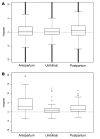Gene expression analysis in pregnant women and their infants identifies unique fetal biomarkers that circulate in maternal blood
- PMID: 17885688
- PMCID: PMC1978418
- DOI: 10.1172/JCI29959
Gene expression analysis in pregnant women and their infants identifies unique fetal biomarkers that circulate in maternal blood
Abstract
The discovery of fetal mRNA transcripts in the maternal circulation holds great promise for noninvasive prenatal diagnosis. To identify potential fetal biomarkers, we studied whole blood and plasma gene transcripts that were common to 9 term pregnant women and their newborns but absent or reduced in the mothers postpartum. RNA was isolated from peripheral or umbilical blood and hybridized to gene expression arrays. Gene expression, paired Student's t test, and pathway analyses were performed. In whole blood, 157 gene transcripts met statistical significance. These fetal biomarkers included 27 developmental genes, 5 sensory perception genes, and 22 genes involved in neonatal physiology. Transcripts were predominantly expressed or restricted to the fetus, the embryo, or the neonate. Real-time RT-PCR amplification confirmed the presence of specific gene transcripts; SNP analysis demonstrated the presence of 3 fetal transcripts in maternal antepartum blood. Comparison of whole blood and plasma samples from the same pregnant woman suggested that placental genes are more easily detected in plasma. We conclude that fetal and placental mRNA circulates in the blood of pregnant women. Transcriptional analysis of maternal whole blood identifies a unique set of biologically diverse fetal genes and has a multitude of clinical applications.
Figures


Similar articles
-
[Noninvasive prenatal screen of trisomy-21 using maternal plasma fetal free RNA allelic ratio].Zhonghua Fu Chan Ke Za Zhi. 2015 Aug;50(8):568-75. Zhonghua Fu Chan Ke Za Zhi. 2015. PMID: 26675178 Chinese.
-
Placenta-derived fetal specific mRNA is more readily detectable in maternal plasma than in whole blood.PLoS One. 2009 Jun 10;4(6):e5858. doi: 10.1371/journal.pone.0005858. PLoS One. 2009. PMID: 19516908 Free PMC article.
-
Epsilon globin gene expression in developing human fetal tissues.J Neonatal Perinatal Med. 2016;9(1):91-7. doi: 10.3233/NPM-16915052. J Neonatal Perinatal Med. 2016. PMID: 27002261
-
Prenatal diagnosis using cell-free nucleic acids in maternal body fluids: a decade of progress.Am J Med Genet C Semin Med Genet. 2007 Feb 15;145C(1):5-17. doi: 10.1002/ajmg.c.30115. Am J Med Genet C Semin Med Genet. 2007. PMID: 17299735 Review.
-
Integration of noninvasive prenatal prediction of fetal blood group into clinical prenatal care.Prenat Diagn. 2014 May;34(5):409-15. doi: 10.1002/pd.4326. Epub 2014 Feb 5. Prenat Diagn. 2014. PMID: 24431264 Review.
Cited by
-
From prenatal genomic diagnosis to fetal personalized medicine: progress and challenges.Nat Med. 2012 Jul 6;18(7):1041-51. doi: 10.1038/nm.2829. Nat Med. 2012. PMID: 22772565 Free PMC article. Review.
-
Cord blood genomic analysis highlights the role of redox balance.Free Radic Biol Med. 2010 Sep 15;49(6):992-6. doi: 10.1016/j.freeradbiomed.2010.05.026. Epub 2010 Jun 8. Free Radic Biol Med. 2010. PMID: 20566327 Free PMC article.
-
Proof of concept study to assess fetal gene expression in amniotic fluid by nanoarray PCR.J Mol Diagn. 2011 Sep;13(5):565-70. doi: 10.1016/j.jmoldx.2011.05.008. Epub 2011 Aug 9. J Mol Diagn. 2011. PMID: 21827969 Free PMC article.
-
The Effect of Pregnancy on Production of Maternal Endogenous Hematopoietic Stem Cells.Biosci Hypotheses. 2008;1(2):100-102. doi: 10.1016/j.bihy.2008.02.012. Biosci Hypotheses. 2008. PMID: 19122820 Free PMC article.
-
Maternal HLA panel-reactive antibodies in early gestation positively correlate with chronic chorioamnionitis: evidence in support of the chronic nature of maternal anti-fetal rejection.Am J Reprod Immunol. 2011 Dec;66(6):510-26. doi: 10.1111/j.1600-0897.2011.01066.x. Epub 2011 Sep 27. Am J Reprod Immunol. 2011. PMID: 21951517 Free PMC article.
References
-
- Poon L.L.M., Leung T.N., Lau R.K., Lo Y.M.D. Presence of fetal RNA in maternal plasma. Clin. Chem. 2000;46:1832–1834. - PubMed
-
- Costa J.M., et al. Fetal expressed gene analysis in maternal blood: A new tool for noninvasive study of the fetus. . Clin. Chem. 2003;49:981–983. - PubMed
-
- Qinyu G., Quanjun L., Yunfei B., Wen T., Lu Z. A semi-quantitative microarray method to detect fetal RNAs in maternal plasma. Prenat. Diagn. 2005;25:912–918. - PubMed
Publication types
MeSH terms
Substances
Grants and funding
LinkOut - more resources
Full Text Sources
Other Literature Sources
Medical
Molecular Biology Databases
Miscellaneous

